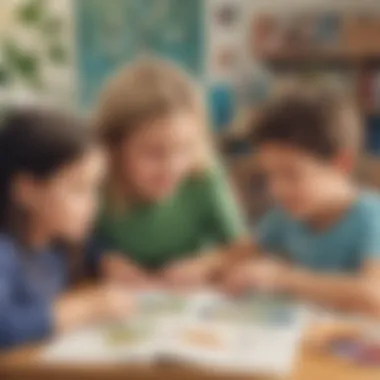Exploring the Five Senses in Child Development


Intro
Understanding the concept of the five senses is essential for enhancing child development and lifelong learning. The senses of sight, hearing, taste, touch, and smell are gateways to experiencing the world. They influence how children interact with their environment and each other. This article aims to provide a comprehensive guide for parents, educators, and caregivers on how to integrate sensory awareness into education. Through structured teaching methods and engaging activities, we will explore effective strategies for instilling a deep appreciation for each sense.
While discussing the five senses, practical applications and educational standards will be outlined. Emphasis will be placed on sensory play, which is not only enjoyable for children but also vital for cognitive and emotional growth. We will also delve into interactive learning games tailored specifically for enhancing sensory experiences, followed by a section on tips for making learning enjoyable and accessible.
As we navigate through this exploration, the goal is to equip adults with actionable insights that foster a rich learning environment focusing on sensory engagement. Let us embark on this journey of discovery together.
Intro to the Five Senses
Understanding the five senses is crucial in early childhood education. It connects children to the world around them. This topic is significant because it lays the foundation for how children interact and learn. By exploring senses, educators can foster a deeper understanding of various subjects.
Understanding Sensory Development
Sensory development starts from birth. Infants engage their surroundings using sight, sound, taste, touch, and smell. These interactions are not just explorations; they are essential learning moments. Children begin to recognize the properties of objects through sensory details. For instance, a child might notice the smoothness of a ball through touch or the vibrant colors during playtime. This process helps form cognitive connections that are vital for later learning.
Research indicates that sensory experiences shape neural pathways. Therefore, when children explore their senses, they enhance their brain development. Simple activities like finger painting or listening to music can stimulate sensory growth. These experiences improve not just academic performance but also social skills and emotional well-being.
Importance of the Five Senses in Learning
The five senses contribute significantly to educational outcomes. They are gateways to engaging lessons. When children learn about their senses, they can process information more effectively. For example, using visual aids can enhance understanding in science and art.
Each sense plays a unique role:
- Sight allows children to observe and analyze.
- Hearing develops listening skills, critical for communication.
- Taste introduces concepts of biology and nutrition.
- Touch enhances fine motor skills through tactile activities.
- Smell can trigger memories, making learning more vivid.
Educational strategies that incorporate the senses can lead to more meaningful experiences. When lessons are multi-sensory, children are more likely to remember what they learn. This approach not only supports cognitive growth but also instills a sense of curiosity and wonder about the world.
"By engaging all five senses, educators create dynamic learning environments that encourage exploration and understanding."
Sight: The First Sense
Sight plays a pivotal role in how children perceive and interact with the world around them. It is often the sense that serves as the primary channel for gathering information. Through visual stimuli, children develop their cognitive skills and understanding of their environment. Engaging children in activities focused on enhancing their visual skills can significantly contribute to their overall learning experience. This section delves into the importance of vision in learning, strategies to enhance visual awareness, and the exploration of colors and shapes.
The Role of Vision in Learning
Vision is more than just a means of seeing; it is a complex process that involves interpreting visual information. Research indicates that up to 80% of a child’s learning comes through sight. This underscores the necessity for parents and educators to prioritize visual learning strategies. Children use their sight to recognize faces, identify objects, and comprehend spaces. A well-developed visual perception is essential for skills such as reading, writing, and even problem-solving. Moreover, vision affects emotional responses, influencing a child's mood and attitude towards learning.
Activities to Enhance Visual Awareness
To cultivate visual awareness, various engaging activities can be implemented. Here are a few effective strategies:
- Scavenger Hunts: Organizing a scavenger hunt where children must find items of specific colors or shapes can sharpen their ability to observe details.
- Picture Books: Reading picture books together encourages children to look closely at illustrations and interpret narratives through visuals.
- Memory Games: Using cards with images, memory games reinforce both memory and visual processing skills, promoting attentive observation.
- Art Projects: Involving children in art, such as painting or drawing, allows them to explore colors and forms, promoting creativity alongside visual development.
These activities encourage children to actively engage with visual stimuli, sharpening their ability to notice details and enhancing their overall understanding of concepts.
Exploring Colors and Shapes
Understanding colors and shapes forms the foundation of many educational concepts. Teaching children about different colors can be exciting and informative. Color recognition plays a significant role in cognitive development. Children learn to categorize their environment, improving their observational skills. Activities like color sorting games or painting can enhance this understanding. Similarly, shapes provide a basis for understanding geometry and spatial relationships. Here are some methods to explore colors and shapes:
- Color Mixing Experiments: Allow children to mix primary colors to see how secondary colors are formed. This teaches fundamental concepts of color theory.
- Shape Hunt: Create a shape hunt where children identify and classify objects in their surroundings based on shape.
- Building Blocks: Using building toys, children can explore 3D shapes, enhancing their spatial awareness.
By incorporating exploration of colors and shapes into learning, children can build a strong foundation for more complex visual tasks later in life. Visual activities not only foster creativity but also improve critical thinking and problem-solving skills.
"Vision is more than a sense; it is the lens through which children understand the world."
In summary, sight is a fundamental aspect of learning in children. By focusing on the importance of visual engagement and implementing effective activities, educators and parents can significantly enhance a child's learning experience.


Hearing: The Sound of Learning
Hearing plays a crucial role in a child's development and learning journey. It goes beyond mere perception of sounds. The ability to differentiate between various noises, tones, and pitches is essential for effective communication and understanding the environment. Engaging with sounds can stimulate cognitive processes and enhance learning capabilities.
The Significance of Auditory Skills
Auditory skills form the foundation of how children understand spoken language. These skills include the ability to hear, process, and interpret sounds. Children with strong auditory skills find it easier to learn vocabulary, follow directions, and engage in conversations. The importance of these skills is evident in several areas:
- Language Development: Auditory skills are key to acquiring language. Children learn new words and sentence structures by listening.
- Communication: Good hearing allows children to express themselves clearly. They can convey their thoughts and feelings effectively.
- Academic Performance: Subjects like reading and music rely heavily on auditory processing. Children with well-developed auditory skills often perform better academically.
Listening Activities for Engagement
To nurture auditory skills, various engaging listening activities can be employed. These activities encourage active participation and focus. Some examples include:
- Storytime Listening: Read books aloud and pause to ask questions. This method fosters comprehension skills and retention.
- Sound Recognition Games: Use everyday objects to create sounds. Have children identify the source of each sound. This can enhance their listening ability and sound discrimination.
- Listening to Music: Introduce children to different music genres. Discuss the emotions each type evokes, promoting awareness of auditory experiences.
Rhythm and Sound Games
Incorporating rhythm and sound games into learning serves as a fun way to bolster auditory skills. These games improve listening and concentration while providing an enjoyable experience. Here are some ideas:
- Clap and Repeat: Teacher claps a rhythm, and children repeat it. This activity sharpens memory and improves rhythm recognition.
- Sound Matching: Children use cards featuring various sounds. They match cards to the correct sound being played. This activity develops auditory memory and focus.
- Animal Sounds Game: Have children identify animals based on their sounds. This engages critical thinking and helps connect sounds to their meanings.
Importantly, fostering auditory skills not only aids in learning but also enhances social interactions.
By exploring these activities, educators and caregivers can create a supportive atmosphere that champions the importance of hearing in a child's educational journey.
Taste: Culinary Exploration
Taste plays a crucial role in child development and can significantly enhance learning experiences. Engaging with culinary exploration allows children to utilize their sense of taste, which can aid in understanding their environment and sharpen their cognitive skills. This exploration fosters sensory awareness and encourages children to develop preferences, connections, and memories associated with various foods.
Understanding the impact of taste on learning is essential. In many educational systems, sensory-rich experiences can deepen cognitive processing and enhance retention of information. Therefore, introducing culinary activities not only appeals to children's natural curiosities but also provides a hands-on approach to explore scientific, cultural, and nutritional aspects of food.
Understanding Taste Buds
Taste buds are specialized sensory receptors that play an essential role in the perception of taste. They are located on the tongue and other areas inside the mouth. Each bud contains taste receptor cells that respond to different types of taste: sweet, salty, sour, bitter, and umami. By educating children about taste buds, we open pathways for them to explore flavors and how their bodies react to various foods.
This knowledge is vital as it connects sensory experiences to scientific concepts, fostering an environment where children can learn about biology through tasting activities. Understanding taste buds also helps underscore the importance of balanced nutrition, guiding children to make health-conscious decisions while enjoying diverse flavors.
Taste Tests: A Learning Experience
Conducting taste tests is a practical and engaging way to explore the sense of taste. These can involve sampling a variety of foods, ranging from fruits to spices, allowing children to describe their preferences and experiences. This hands-on approach can ignite discussions about flavors, textures, and cultural significance of food.
- Benefits of Taste Tests:
- Encourage critical thinking: Children can express why they like or dislike certain tastes.
- Develop descriptive language: They learn to articulate their experiences with adjectives such as "sweet," "spicy," or "sour."
- Foster social interactions: Taste testing can be a cooperative activity, where children share opinions and learn from one another.
Taste tests can be easily incorporated into lessons focusing on various subjects, including science, geography, and health education. By connecting culinary activities with curriculum goals, we enhance the overall learning experience while making education enjoyable.
Incorporating Culinary Activities into Lessons
Incorporating culinary activities into lessons can benefit multiple learning styles and engage children more effectively. One method is to create thematic lessons around food. For example, a lesson about local cultures can involve cooking traditional dishes from those regions, providing a firsthand experience of the food's significance.
Activities may include:
- Food Science Experiments: Exploring the chemical reactions that occur when cooking or baking, helping children understand the science behind taste.
- Gardening Projects: Growing herbs or vegetables, creating a direct link from farm to table, and encouraging healthy eating habits.
- Cooking Classes: Teaching children simple recipes allows them to practice measurements and instructions, reinforcing math and comprehension skills.
By blending culinary exploration with education, children not only enhance their sensory awareness but also gain valuable life skills. The process of understanding taste through experience can greatly enrich their learning journey.


Touch: The Tactile Experience
The sense of touch plays a crucial role in sensory development and learning for children. Understanding how tactile experiences shape perception is essential. Touch integrates various physical sensations, like pressure, temperature, and texture. This process helps children explore their environment and understand their surroundings. Through touch, learners can develop fine motor skills and enhance their cognitive abilities.
The Importance of Tactile Learning
Tactile learning is significant in early childhood education. Children learn best when they can physically interact with materials. This sense contributes to memory, comprehension, and problem-solving. Research shows that hands-on experiences reinforce concepts. When a child engages in tactile activities, they create lasting memories about what they learn. Therefore, prioritizing tactile learning can foster a deeper understanding of various subjects.
"Touch stimulates brain development, enhancing engagement and retention in learning."
Children with diverse learning styles may benefit substantially from tactile engagement. It promotes concentration and focus, allowing them to absorb knowledge effectively. Additionally, tactile experiences often lead to greater enjoyment in learning, encouraging a positive attitude toward education.
Sensory Bins and Hands-On Activities
Sensory bins are an effective way to promote tactile learning. These bins can include various materials: beans, rice, sand, or water beads. Children can explore different textures by digging, pouring, and sorting. This hands-on approach complements traditional learning methods. Educators can easily integrate sensory bins into lesson plans. They can create them around specific themes or subjects to reinforce key concepts.
Some activities to consider include:
- Color Sorting: Use colored objects in the bins for children to sort by hue.
- Nature Exploration: Incorporate leaves, stones, and soil to connect with nature.
- Themed Bins: Create seasonal or holiday themes to spark interest.
These bins not only help with tactile exploration but also enhance critical thinking. When children manipulate objects, they develop logic and reasoning skills. Furthermore, sensory bins can be relaxing, providing soothing experiences that reduce stress.
Using Textures to Enhance Learning
Textures can significantly impact how children learn and engage with their surroundings. Introducing a variety of surfaces – soft, rough, bumpy, and smooth – can deepen their understanding of the world. Educators can incorporate textured materials into lessons through specific activities.
For example:
- Art Projects: Using sandpaper, fabric, or foil in craft projects allows children to explore textures.
- Storytelling: Reading books with different textures engages children in literature while appealing to their sense of touch.
- Games: Simple games involving finding objects with different textures can enhance sensory awareness.
Touch can also facilitate social interactions. When children work together on tactile projects, they develop communication skills. The sense of touch encourages collaboration and sharing. It can create a safe environment for expression, which is fundamental in educational settings.
Smell: The Sense of Awareness
The sense of smell, or olfaction, plays a crucial role in how individuals interact with their environments. Unlike other senses, smell is often less discussed in educational contexts. However, it has distinct benefits that can enhance learning experiences. Smell can evoke memories and feelings, creating a deeper connection between learners and their surroundings. This section focuses on the specific elements related to olfactory learning and its implications for child development.
The Role of Olfactory Learning
Olfactory learning significantly influences children's cognitive and emotional development. This sense is one of the earliest to develop in humans, beginning in the womb. Children use their sense of smell to explore their world. The scents around them contribute to their understanding of safety, food, and their surroundings. Engaging with scent helps to form neural pathways that facilitate learning and memory. It can also encourage curiosity. For instance, the smell of freshly baked bread can trigger feelings of comfort and joy, promoting positive learning experiences.
Smell and Memory Connection
Research indicates a strong link between smell and memory. The olfactory bulb, which processes scents, is closely tied to the limbic system, the area of the brain responsible for emotions and memories. This connection means that certain scents can evoke vivid memories. For children, creating associations between smells and specific concepts can enhance retention of information. Using scents in lessons can therefore bolster memory recall. For example, introducing a lesson on nature with the scent of pine or flowers helps children to remember the lesson better.
"Smell can help us recall memories long after the experience has happened, making it a powerful learning tool."
Activities That Explore Different Scents
Incorporating smell-based activities in the curriculum can engage children's interest and spark their imagination. Here are some educational activities designed to explore different scents:
- Scented Sensory Bins: Fill bins with various items such as herbs, spices, and flowers. Let children explore and identify the scents. This can facilitate discussions about nature, cooking, and even cultural practices related to foods.
- Smell Matching Game: Prepare a set of containers with different scents. Children must match scents to corresponding pictures or descriptions. This helps enhance their understanding of the olfactory world.
- Cooking Activities: Engage children in cooking simple recipes. The smells from cooking not only teach about food and nutrition but also allow for discussions on the science of smell and taste.
Integrating such activities into lessons helps children experience the world through olfaction, making learning richer and more memorable.
Integrating the Five Senses in Education
Integrating the five senses in education is essential because it deeply influences how children understand and interact with the world around them. Each sense offers unique insights, contributing to a richer learning experience. By engaging multiple senses, learners can retain information more effectively and develop critical thinking skills. The integration not only enhances cognitive development but also promotes emotional and social skills.


Creating a Multi-Sensory Learning Environment
A multi-sensory learning environment is designed to stimulate all senses. This approach acknowledges that not every child learns in the same way. By incorporating sight, sound, taste, touch, and smell, educators can foster creativity and curiosity. For instance, classrooms might include various posters, sound devices, and tactile materials for students to explore. Classrooms can be organized into zones where different sensory experiences occur, allowing for exploration at different stations. This setup promotes active participation and discovery.
"A multi-sensory approach allows children to engage with concepts through various pathways, enhancing understanding and retention."
Practical Applications in the Classroom
Practical applications of a sensory-based approach are numerous and varied. Activities can be simple, such as aroma testing with different scents for learning about nature, or hands-on, like creating art with assorted textures. Projects can include cooking sessions where kids learn about taste and nutrition or science experiments that use scents and sounds. Such activities with real-world applications can connect theoretical knowledge with practical skills, making learning more relevant and interesting. Teachers can adapt lessons to include sensory walkthroughs, such as nature walks that involve sight, sound, and smell exploration.
Enhancing Curriculum Through Sensory Activities
Enhancing the curriculum through sensory activities can significantly boost engagement. Integrating sensory approaches within existing subjects can create enriching lesson plans. For example, while learning about revisiting plants, a teacher can incorporate growing seeds, touching soil, and observing plant growth. Incorporating textures in reading sessions can also help young readers engage more effectively. The use of sensory activities often sidesteps rigid learning structures, making education more dynamic.
In summary, by integrating the five senses into education, teachers can create a more immersive and effective learning experience. This not only benefits cognitive growth but also encourages a love for learning that can last a lifetime.
Challenges and Considerations
The integration of sensory learning into education presents unique challenges and considerations that educators and caregivers must navigate. Understanding these obstacles is fundamental, as they can significantly affect how children experience and interact with their environment. Addressing sensory processing issues is a primary concern. Some children might have heightened sensitivity or a diminished response to sensory inputs. These varied sensory perceptions can influence learning capabilities. A one-size-fits-all strategy may not suffice; instead, tailored approaches are crucial. By fostering a greater awareness of these issues, educators can adapt their methods to ensure inclusivity and engagement.
Addressing Sensory Processing Issues
Sensory processing issues refer to difficulties in receiving and responding to sensory information. Children with these challenges might overreact to certain stimuli or underreact to others. This can lead to frustration or disengagement during learning activities. Identifying these issues early is essential for effective intervention. It involves close observation and collaboration between teachers and parents.
Creating a supportive learning environment is vital. This can include the use of sensory-friendly spaces where children can retreat when overwhelmed. Educators can also incorporate calming strategies. For example, activities like deep breathing or simple stretching can help children regain focus.
Key strategies for addressing sensory processing issues:
- Routine Establishment: Consistent routines can help children feel secure.
- Sensory Breaks: Regular intervals for sensory breaks allow children to manage their sensory input.
- Individualized Plans: Tailored learning plans cater to specific sensory needs, promoting optimal engagement.
By implementing these strategies, educators can foster an environment conducive to learning for all children, regardless of their sensory processing profiles.
Adapting Activities for Diverse Needs
Diverse needs among children require a flexible approach to activities associated with sensory learning. Recognizing that children learn differently is fundamental. Some may thrive in a hands-on environment, while others benefit from structured, quiet settings.
Activities should, therefore, be adaptable. For instance, during a visual exploration task, one child might respond well to intricate visual puzzles, while another might prefer simpler, larger shape identification games. This adaptability leads to more meaningful experiences.
To ensure inclusivity, educators can:
- Offer Choices: Allow children to select from different types of activities to enhance their motivation.
- Modify Instructions: Use clear, concise language and visual aids to support understanding for all learners.
- Balance Challenge and Skill Level: Tailor activity difficulty to children's abilities, providing both challenge and success opportunities.
"Education is not preparation for life; education is life itself." – John Dewey
Ending and Future Directions
The discussion of the five senses within educational contexts highlights their critical role in child development and learning. In Conclusion and Future Directions, we reflect on the impact of sensory experiences and underscore potential pathways for advancing this integrative approach to teaching.
The Lasting Impact of Sensory Learning
Sensory learning leaves a profound effect on children's cognitive and emotional development. By engaging various senses, children connect information more deeply, facilitating retention and understanding. Research indicates that when sensory experiences are woven into learning, students tend to show better engagement and interest in the material. This approach nurtures curiosity and enhances problem-solving skills, providing children with the tools to navigate their environments effectively.
There are several key impacts of sensory learning:
- Enhanced Memory Retention: Sensory experiences can create strong memories that are easier to recall.
- Increased Engagement: Children are typically more motivated when they interact through multiple senses.
- Holistic Development: Incorporating the senses fosters not just academic learning, but also emotional and social growth.
"The integration of sensory play into educational practices cultivates a more comprehensive learning environment that values the role of exploration and inquiry."
Encouraging Continued Exploration and Discovery
Promoting ongoing exploration is crucial for fostering a love of learning in students. An educational framework that prioritizes sensory engagement encourages children to explore and discover their world. This can be done through personalized experiences that adapt to individual interests and needs.
To support continual exploration, educators and caregivers should:
- Create Sensory-Rich Environments: Utilizing textures, sounds, and visuals can encourage children to engage actively with their surroundings.
- Offer Varied Experiences: Activities should cater to diverse learning styles. Field trips, nature walks and interactive exhibits can help maintain interest.
- Encourage Reflection: Allowing children to express their thoughts and feelings about their sensory experiences fosters deeper comprehension.
Recognizing that sensory learning is not a finite journey but rather an ongoing exploration forms the essence of a fruitful educational philosophy. Moving forward, educators should remain committed to innovating and refining sensory-based methods. As the future of education evolves, the five senses will continue to play an essential role in shaping learning paradigms.















